| Columns Retired Columns & Blogs |
I've had this iMac for three years and until I read this article I didn't know there were USB jacks on either side of the keyboard. Thanks for that.
I measured the AudioQuest DragonFly Red and Black with my Audio Precision SYS2722 system (see the January 2008 "As We See It"). I performed a full set of tests on both converters with WAV and AIFF test-tone files sourced from an iPad 2 with a 30-pin-to-USB "camera connection kit" adapter. I then repeated some of the testing, playing the same files with Pure Music 3.0 on my MacBook Pro running on battery power, and on my iPhone 6 using a Lightning-to-USB adapter. AudioQuest's Stephen Mejias warned me that the DragonFlys' rejection of jitter would be optimized after they'd been powered up for 24 hours, so before I did any testing, I left both plugged into USB ports on one of the PCs in my lab for 36 hours.
Apple's USB Prober utility identified the DragonFlys as "AudioQuest DragonFly Red v1.0" and "AudioQuest DragonFly Black v1.5," both from "AudioQuest." Both converters' USB ports operated in the optimal isochronous asynchronous mode, and Apple's AudioMIDI utility revealed that they accepted 24-bit integer data sampled at all rates from 44.1 to 96kHz. The DragonFlys' maximum output levels at 1kHz into a high 100k ohms load were 1.19V (Black) and 2.04V (Red). Both DragonFlys preserved absolute polarity (ie, were non-inverting), and both offered a very low output impedance of <1 ohm.
Fig.1 shows the DragonFly Red's impulse response with 44.1kHz data. (The Black's impulse response was identical.) It is typical of a minimum-phase reconstruction filter, with all the ringing following the single full-scale sample. This filter has a very sharp rolloff above the audioband (fig.2, magenta and red traces), with the aliasing image at 25kHz of a full-scale tone at 19.1kHz (cyan, blue) being suppressed by >110dB. This graph was taken with the Red, and the harmonics associated with the 19.1kHz tone all lie below –80dB. The Black's reconstruction filter offers similar rejection above the audioband (fig.3), but the harmonics of the 19.1kHz tone are all higher in level, at –57dB (0.14%).
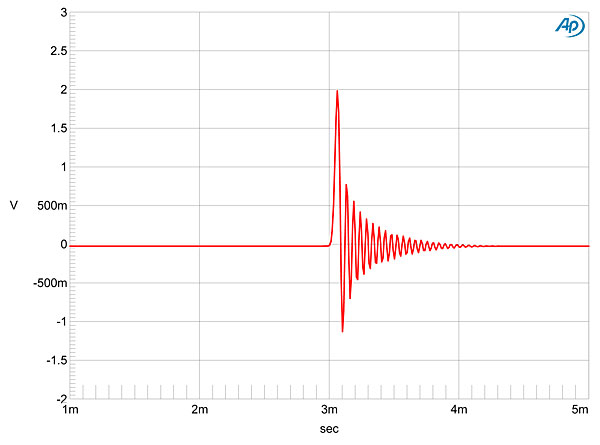
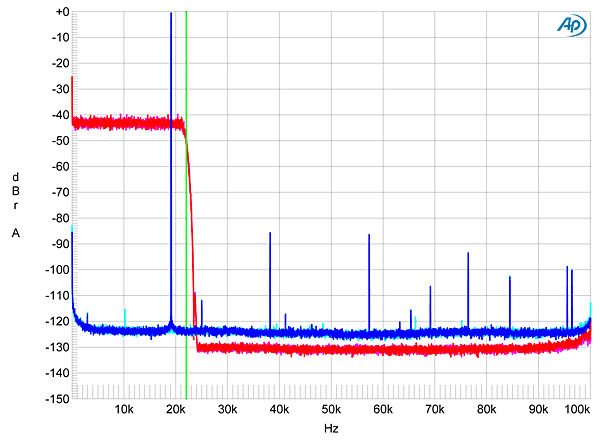
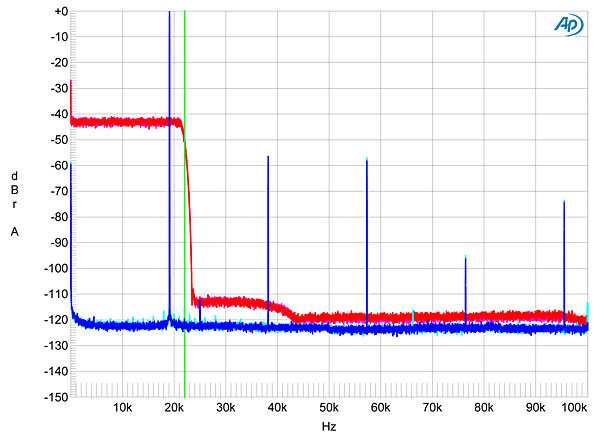
Fig.4 shows the Red's frequency response with data sampled at 44.1 and 96kHz. The smooth rolloff above the audioband is broken by a sharper drop just below half of each rate. Channel separation at 1kHz was excellent, at 110dB R–L and 115dB L–R, but decreased to 75 and 87dB, respectively, at 20Hz. I measured the channel separation with the DragonFly Red connected to the iPad 2. This increase in crosstalk at low frequencies is usually due to increasing power-supply impedance, so I repeated the test with the MacBook Pro, only to get an identical result.
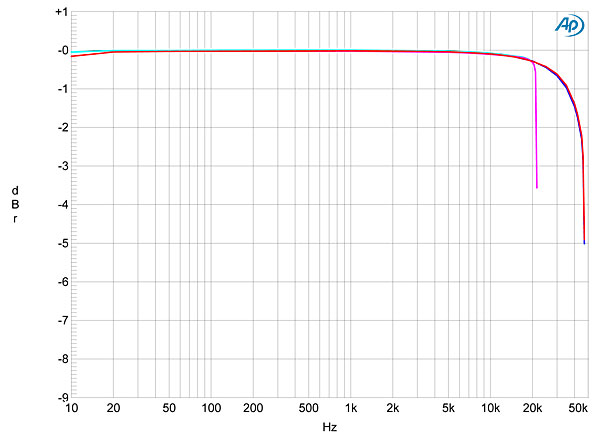
An increase in bit depth from 16 to 24, with dithered data representing a 1kHz tone at –90dBFS, dropped the Red's noise floor by almost 12dB (fig.5), suggesting a resolution of around 18 bits—good for a DAC powered by an iPhone or iPad, and a little better than that of the original DragonFly, particularly at low frequencies. Repeating this test with the Black (fig.6) suggested that the less expensive DragonFly offers 17 bits' worth of resolution, though this is still good enough to allow it to decode a 24-bit tone at –120dBFS (fig.7). When I played undithered data representing a tone at exactly –90.31dBFS, the waveform was symmetrical, with no DC offset, but the three DC voltage levels described by the data were obscured by high-frequency noise (fig.8).
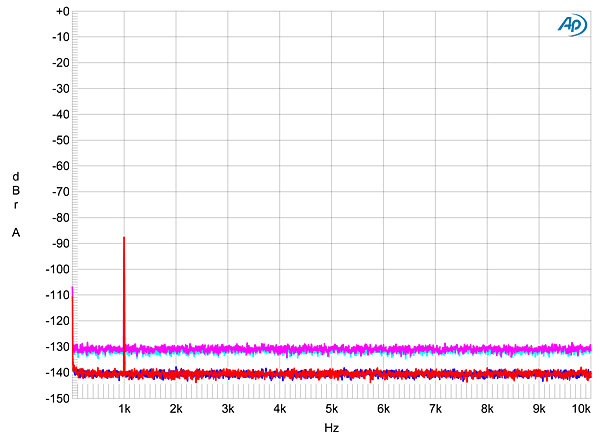
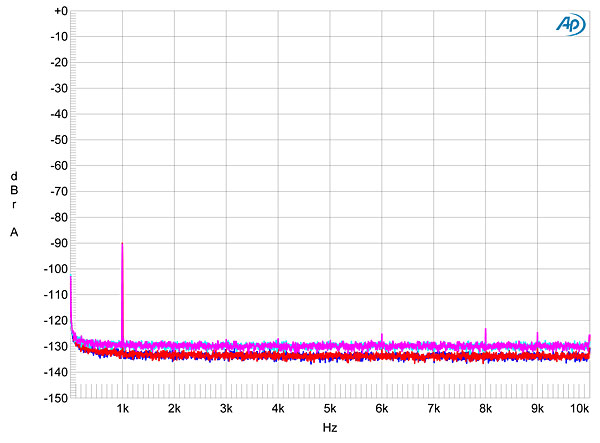
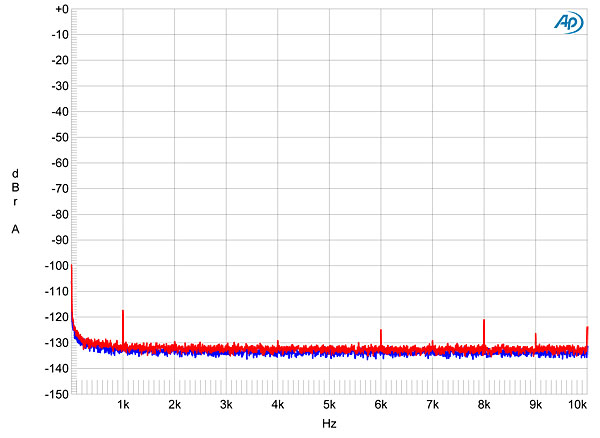
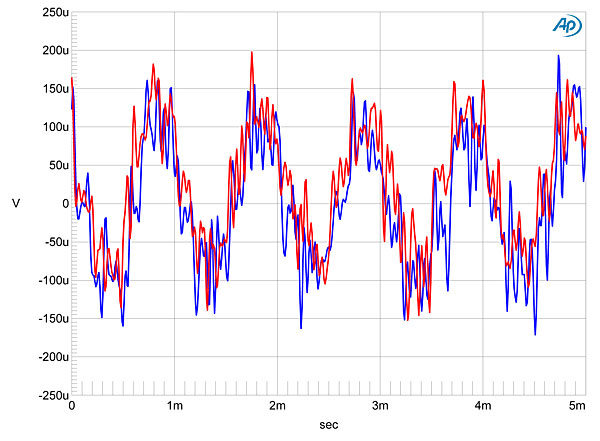
So far, all testing had been performed with the high 100k ohm load, and the Red produced very low harmonic distortion with this load (fig.9). However, the DragonFlys will mainly be used with headphones, which have impedances ranging from 20 to 300 ohms—and with the Red, things went a tad gnarly into low impedances. With 300 ohms, I had to reduce the signal level to –3dB to avoid clipping the output; and into 30 ohms, the signal had to be brought down to –5dB to reduce the harmonic distortion to an appropriately low level (fig.10), the second and third harmonics now lying close to –80dB (0.01%). It's fair to note that a level of –5dB was still way too loud for me to bear with the Red driving my Ultimate Ear 18 Pros, whose impedance ranges from 12 to 30 ohms.
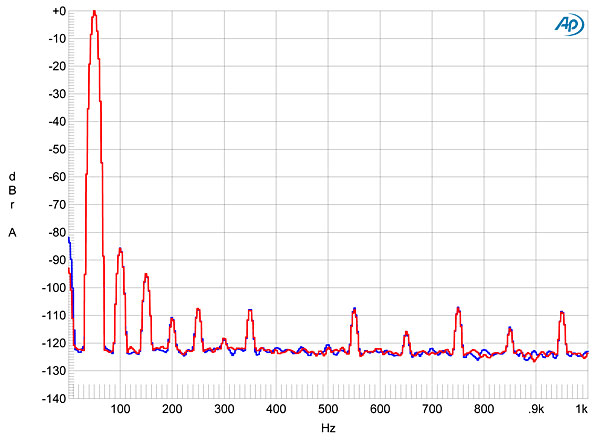
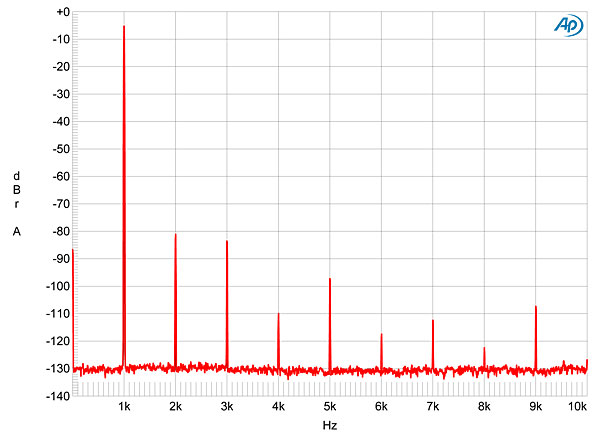
With its lower maximum output level, the DragonFly Black coped better with low impedances, though the harmonic distortion was generally a little higher than that of the Red (fig.11), with the third harmonic the highest in level, at –73dB (0.025%). Both DragonFlys offered low levels of intermodulation distortion, though again, the Black (fig.12) performed a little worse than the Red (fig.13) when reproducing an equal mix of 19 and 20kHz tones, the combined waveform peaking at 0dBFS.
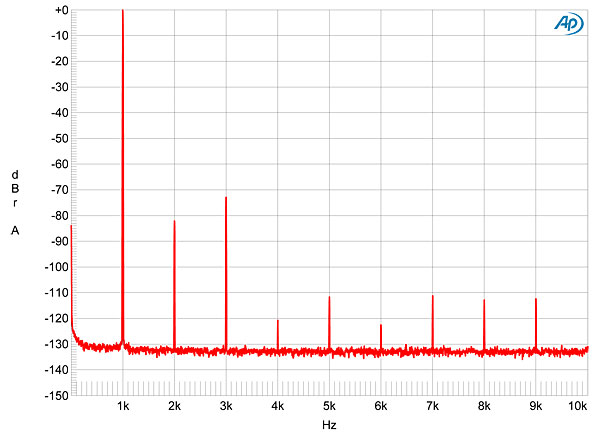
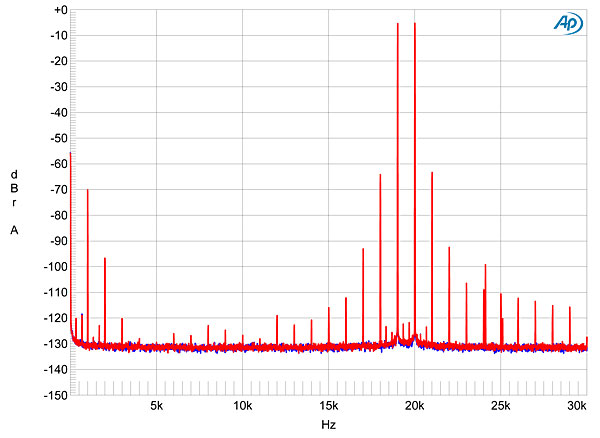
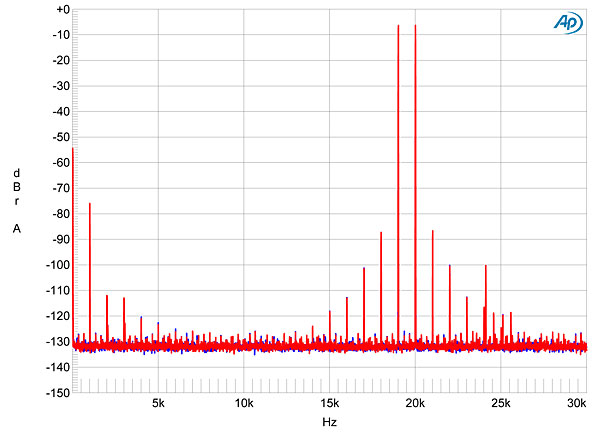
Even after 36 hours of burn-in, the DragonFly Red's rejection of word-clock jitter was disappointing. When I fed it 16-bit J-Test data, the lowest-frequency sidebands, at ±229Hz, were slightly accentuated (fig.14; the correct levels are shown by the green line); of more concern was the symmetrical modulation of the noise floor just over 3kHz to either side of the spectral spike that represents the high-level tone at one-quarter the sample rate. This graph was taken with the DragonFly Red driven by the MacBook Pro and it turned out that behavior was due to an interaction between the Audio Precision's input stage and the Red's ESS headphone amplifier. (See "Manufacturers' Comments.") Fig.15 shows a spectral analysis taken with 24-bit J-Test data sourced from the iPad2 and the Red's output digitized with an Ayre QA-9 ADC; the spectrum is now much cleaner. The DragonFly Black performed better with J-Test data analyzed with the Audio Precision (fig.16), though a low-level spurious tone can be seen at 12kHz.
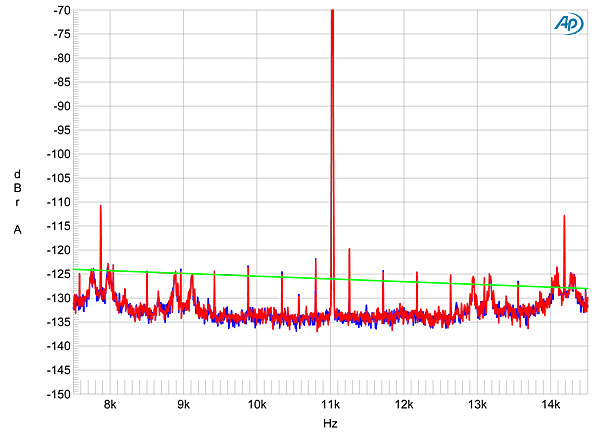
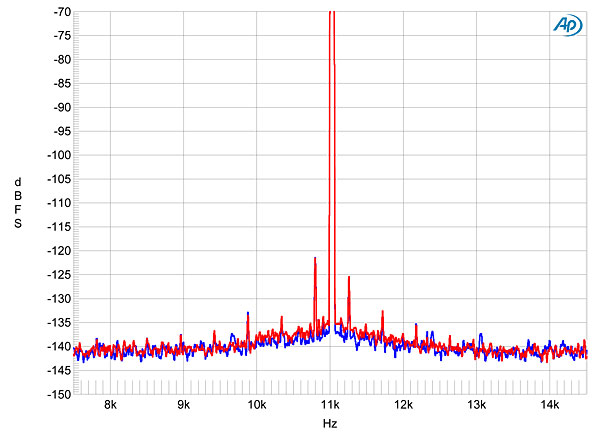
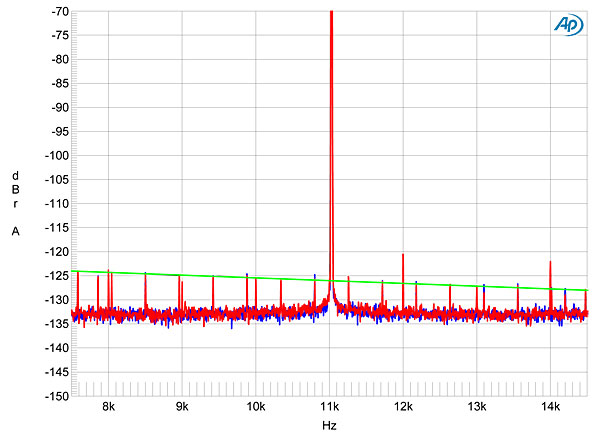
AudioQuest's DragonFly Red and Black performed well on the test bench. The Black's measured performance is especially commendable when you consider that it costs just $99! The higher maximum output level of the Red will be a benefit when it's used to feed a preamplifier, but will not be a factor when it drives the lower impedances typical of headphones.—John Atkinson

I've had this iMac for three years and until I read this article I didn't know there were USB jacks on either side of the keyboard. Thanks for that.

If I remember correctly, they advise against using any but the main USB jacks for the DragonFlys.

I thought about the Dragonfly, seriously.
Then my local dealer had a rock-solid alternative: the Arcam r-Pac. The r-Pac is marginally less "portable" than this product. It is a full headphone amp/DAC offering performance of headphone amps costing many times more.
The r-Pac is a true piece of gear, made with the trappings of Arcam's higher-up-the-food-chain DACs of high repute. I hope that Stereophile will review the r-Pac in the coming days. It even has a Brown-Burr processor.
You can't use the r-Pac on-the-go, though just about any portable DAC would be a tough-sell to use in a less-than-stationary listening environment. It does square the circle on two key dimensions: 1. it is USB-powered; 2. it is a solid piece of gear with a top-rate processor; it might even double as a full home-system DAC while doubling for headphone use during the week at work.

I know people who do like the r-Pac a lot. For me, the amp makes the biggest difference, as this review alluded to. The DACs not so much. So it would be good for someone to compare the Red to the r-Pac, on headphones.

Dudley wrote:
"To use either new DragonFly with current-spec Apple iOS hardware requires the purchase, from Apple or an authorized Apple supplier (footnote 1), of a $29 accessory: a Lightning-to-USB-camera adapter."
So when AAPL announces removal of the 3.5mm jack next week, I do think the Lightning phone + camera adapter + Dragonfly approach will be a nifty solution for those unwilling to give up their favorite cans. Just remember to carry all of them with you!
;-)

I was directed to this article by a link in an 5/12/17 article on this site written by Jason Victor Serinus entitled "Munich Milestones for MQA."
In reading your (this) article, I noticed on page two, a photo of what appears to be a DragonFly Black connected to an AudioQuest JitterBug, which is connected to the USB port of an unidentified notebook computer (decidedly not an iMac). I find no mention of the JitterBug or the notebook computer in the body of your review or in the listing of Associated Equipment. This photo is somewhat confusing to me. Couldn't you use the very good camera in your iPhone 6 Plus to take a photo of the actual iMac setup mentioned in the article?

why don't you quantify "musical nuances." FFS you guys are so full of dog $h!t.
are you guys owned by the fox news or what.
I also liked “Now there was no air between notes—just . . . stuff.” ROFL
WTH is that?
Also amusing were “more musical color, sounded a bit mushy, impression of flesh and blood, music exhibited more momentum (omfg lol), huge sound,..”
“high-and-mighty high-end talk”, you mean unadulterated BS.
You guys are some piece of work.